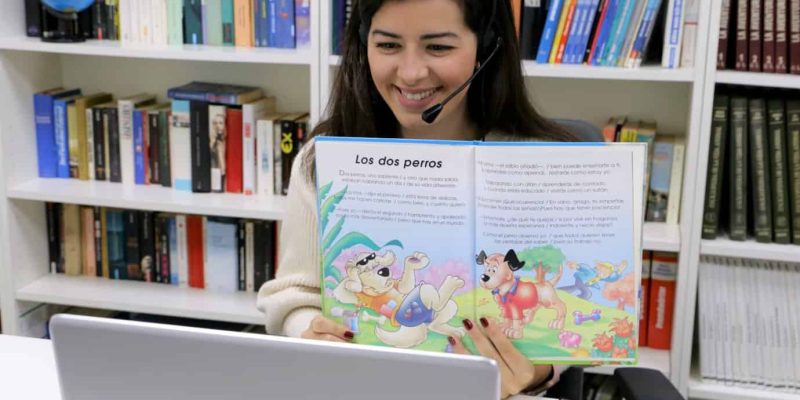Spanish for Children - The Must-Know for Parents

-
Save
Children's brains are like sponges, soaking up information from all around them.
We say that for several reasons. Babies form more than a million neural connections from birth to age three every second. The fact that children learn languages so quickly and effortlessly is no surprise.
Dr. Patricia Kuhl’s research at the Institute for Learning and Brain Sciences at the University of Washington shows that babies can distinguish and eventually produce the sounds of all the world’s different languages!
However, gradually their neurons commit to the omnipresent mother tongue, and they lose their “ear” for foreign sounds.
Good news, though! Early exposure to language can help retain the ability.
While it is highly beneficial to start learning as early as possible, older children still have an advantage in learning. They absorb the information much faster and can copy sounds that we, as adults, can’t do skillfully.
What is Intentional Bilingualism?
Intentional bilingualism occurs when parents introduce a foreign language into their child’s world while not being native speakers themselves.
Are you familiar with the basics of Spanish?
Did you learn Spanish at some point your life, but you don't remember much of it?
Maybe you don't speak Spanish at all?
It doesn’t matter what your answer is. You can teach your child Spanish and encourage him to become bilingual. Combining online lessons for kids with some home practice will be the most effective. Check out our Spanish lessons for kids. They are tailored to your child’s needs.
Let’s forget about the strict perception of bilingualism from the past decades. According to the more and more popular definition of the professor Francois Grosjean, you are a bilingual person if you communicate in two languages on a daily basis.

-
Save
What does that mean?
Raising bilingual kids isn't just for couples from different cultures. By providing your child with adequate language exposure on a daily basis, you also have this opportunity.
Learning Languages Through Fun
Learning the fun way may seem like just a catchphrase.
But trust us, there is much more to it!
There is a lot of neuroscientific proof that having fun activates our emotional brain and reinforces information retention.
In any children’s game, symbolic or locomotor play, there is much more to it than just entertainment. Children test their physical skills, expand their social skills and train their cognition.
Playing and having fun are crucial ways for children to learn and develop their intellect, physical skills, and emotional abilities.
Music, games, and stories work best to help children learn. These activities allow for introducing learning-inductive techniques, such as movement, repetition, and multimodality. Music is a direct pathway to the brain that brings global cognitive benefits.

-
Save
A study conducted in Macedonia showed that teaching foreign languages in a game-based manner increases the motivation of students and their positive association with the foreign language.
On the other hand, a story provides children with the opportunity to absorb information about the rhythm and intonation of the language and learn new vocabulary in a contextualized way.
Check out our list of Spanish books for kids! Here you can find plenty of ideas on exposing your child to high-quality language learning.
The Key to Learning is Interaction

-
Save
A study carried out by Patricia Kuhl, the co-director of the Institute for Brain and Learning Sciences at the University of Washington, focused on foreign language acquisition by nine months old infants.
One of the groups learned Mandarin with a native speaker, the other learned with audio and video exposure, and the last just by listening to the audio.
Are you able to guess which group had the best results?
Yes, it was by far the group taught by the native speakers. Human interaction is invaluable at this stage.
Electronic media doesn’t provide the same rich experience as interactive communication. Studies on preschoolers have found similar results. Although vocabulary can be learned with videos, more complicated aspects of the language cannot be understood by watching TV without interaction.
This is why online classes with native speakers produce better results than passively watching an electronic media program.
You have a crucial role to play, too. Engaging a child’s parents has improved motivation and created positive associations with foreign languages. Spanish lessons can be a great bonding experience for the whole family.
Don’t be afraid to practice Spanish with your child!
Regardless of your level, you can prepare a Spanish-language game. Keep a dictionary nearby and check the pronunciation online. You can find many online Spanish resources to use.

-
Save
Mistakes as a Part of the Process
Learning diagrams for children tend to be U-shaped. It is common for children to make mistakes as they know and create a rule-governed system as they perform their tasks. This is important to keep in mind to give corrective feedback positively. You can always encourage your child while correcting his errors.
Positive reinforcement is essential in the learning process. We want to avoid words such as “Wrong”, “No”, “Incorrect”. Instead, you can recast the correct answer. Simply repeat what the student said while subtly saying it the right way. Make it sound natural and as if you are contributing to the conversation.
The Nurturing Environment
Children learn best under the right conditions. Children’s affective needs must be met first.
Dr. Jeannette Vos, a Netherlands-born American doctor of education, spent many years researching the importance of surroundings in language acquisition. According to her studies, healthy learning can only occur in a stress-free, nurturing environment.
Various researchers emphasize the importance of letting the child absorb the input first and discourage parents and educators from forcing children to speak a foreign language when they are not ready. Every child develops differently, and each should be treated as an individual.
Spanish for Children is a Strong, Global Player
If you are here, you probably already have your reasons for teaching your child Spanish.
We know so little about the Spanish language though, right?
Did you know that Spanish is the second most spoken language in the world?
In addition, Spanish is an official language in 21 countries. Spanish’s Latin roots are another encouraging feature. Once kids learn Spanish, it is much easier to understand other languages with Latin roots, such as French and Portuguese.
Moreover, Spanish skills improve your child’s work opportunities. Around the world, Spanish-speaking candidates are highly sought after by international companies.
Check out our Spanish classes if you’re thinking about teaching your child Spanish. Native Spanish speakers teach the language.
The way we teach Spanish is fun and effective.
With us as Spanish Teachers, your child is learning a language in a comforting environment and without effort!
Stress free and fun!
Do You Want Your Child to Learn Spanish in the Easiest and Most Efficient Way Possible?

-
Save
With a flexible class schedule, you decide when is the time to take private Spanish lessons for kids.
We teach your kids by giving fun lessons, full of activities and encourage immersion. All you need is an internet connection and computer.

-
Save











